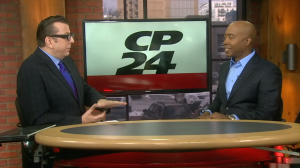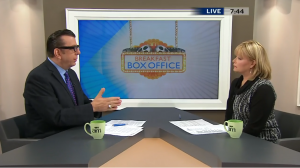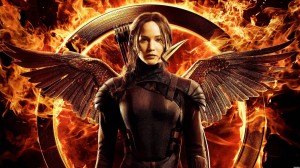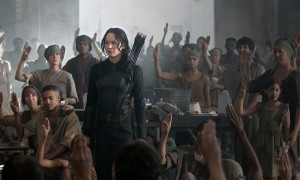RICHARD’S WEEKEND MOVIE REVIEWS FROM CP24! FRIDAY NOVEMBER 21, 2014.
 Richard’s CP24 reviews for “The Hunger Games: MockingJay – Part 1″ and “The Homesman.”
Richard’s CP24 reviews for “The Hunger Games: MockingJay – Part 1″ and “The Homesman.”
Watch the whole thing HERE!
 Richard’s CP24 reviews for “The Hunger Games: MockingJay – Part 1″ and “The Homesman.”
Richard’s CP24 reviews for “The Hunger Games: MockingJay – Part 1″ and “The Homesman.”
Watch the whole thing HERE!
 Richard’s “Canada AM” reviews for “The Hunger Games: MockingJay – Part 1” and “The Homesman.”
Richard’s “Canada AM” reviews for “The Hunger Games: MockingJay – Part 1” and “The Homesman.”
Watch the whole thing HERE!
 “Everything old can be made new again,” says tribute escort Effie Trinket (Elizabeth Banks) in “The Hunger Games: MockingJay – Part 1,” “even democracy.” So, apparently, is the “Harry Potter” model of cleaving the final book in a popular series into two moneymaking movies.
“Everything old can be made new again,” says tribute escort Effie Trinket (Elizabeth Banks) in “The Hunger Games: MockingJay – Part 1,” “even democracy.” So, apparently, is the “Harry Potter” model of cleaving the final book in a popular series into two moneymaking movies.
A better, catchier title for the third part of the Hunger Games tetralogy might be “You Say You Want a Revolution.” “MockingJay – Part 1” takes the action off the playing field and into the realm of rebellion.
With one arrow Katniss Everdeen (Jennifer Lawrence) changed the barbaric Hunger Games forever, opening the door to rebellion. In the surrounding turmoil, her love Peeta (Josh Hutcherson), was left behind in the Capitol and has become a pawn in the propaganda game being played by the totalitarian President Snow (Donald Sutherland) and District 13 rebel leader Alma Coin (Julianne Moore). The revolution to unify the districts against the capitol has begun with Katniss cast as the MockingJay, a reluctant hero but a symbol of hope to the oppressed masses.
“The Hunger Games: MockingJay – Part 1” ups the stakes considerably from the last film, putting several big ideas into motion. The cinematic world created in the first two movies is about to change in very dramatic ways and this movie prepares viewers for the revolution. Katniss looks suitably concerned throughout and there are several effectively staged action scenes, but despite the fine performances and lessons in mass produced anarchy, it’s hard to shake the feeling that this is a place holder for next year’s series finale.
Scenes stating the obvious—“He’s punishing me because I’m the MockingJay!” Katniss reveals in one, “Duh, yeah” scene—feel added in to stretch the movie to its two hour running time.
That’s not to say there isn’t entertainment value here. Far from it. Lawrence takes a role that could have been buried under layers of teen ennui or steely-eyed determination and gives Katniss some real depth and it is a blast to see Moore and Seymour-Hoffman back on screen together again. Sutherland is at his serpentine best and Harrelson and Banks struggle with their new surroundings in entertaining ways; he with sobriety, her with a lack of haute couture.
Most entertaining is the film’s take on the building of a social movement. Katniss is manufactured into the people’s hero. She’s given line readings and a fan to blow her hair around in sexy and stirring propaganda videos and dressed in stylish warrior gear. “Everyone is going to want to kiss you, be you or kill you,” coos Trinket. It’s a handbook to do-it-yourself social unrest and it is smart, funny and on the nose. In the end, however, it’s discovered that Katniss is more effective in her natural state, without meddling hands shaping her. One can’t help but think the same of the movie. Perhaps it might have been satisfying if it too had been left alone and presented in its natural state, as one movie instead of two.
 By Richard Crouse – Metro Canada
By Richard Crouse – Metro Canada
Since the release of the first Hunger Games novel in 2008, literary sleuths have picked it apart, searching for connections to other books and films.
The scrutiny increased when the first film in the tetralogy set records for the biggest opening weekend for a non-sequel in 2012, and continues unabated with the release of this weekend’s The Hunger Games: Mockingjay, Part 1.
Based on Suzanne Collins’s mega-successful series, the movies are set in a dystopian world ruled by a fascist-style president (Donald Sutherland) who presides over The Hunger Games, a televised battle-to-the-death between 24 young players, two from each of the country’s districts, including Katniss Everdeen (Jennifer Lawrence) and Peeta Mellark (Josh Hutcherson).
The series draws on things we’ve seen before, in everything from the human sacrifices of Greek mythology or Survivor-style television shows to news stories of government corruption to create a world with its own rules, style and customs.
The most often-cited influence is Battle Royale, a 2000 Japanese movie based on a book by Koushun Takami. Like The Hunger Games, it’s a story of school kids in a televised government-sanctioned death match.
Battle Royale’s DVD box set even included a quote from a critic suggesting there’d be no Hunger Games without the Japanese film. “This is the movie that started it all,” it reads.
Hunger fans were quick to point out differences in the two films. The Japanese movie is about survival, they said, while Collins wrote about revolution. The author revealed her main influences were reality television and the Iraq war.
“I had never heard of that book or that author until my book was turned in,” she told the New York Times.
It’s worth noting that the idea of humans being preyed upon for the entertainment of the upper classes dates back at least as far as 1932’s The Most Dangerous Game. The story of a big-game hunter who tracks humans for sport on an isolated island is based on a Richard Connell short story that also loosely inspired episodes of everything from Gilligan’s Island to Lost in Space. Since then, Norman Jewison’s Rollerball, Roger Corman’s Deathrace 2000 (and its 2008 Jason Statham remake) and The Running Man have mined similar territory.
As for the author who wrote Battle Royale, he gave ABC News a very diplomatic answer when asked about the similarities between the two stories. “I think every novel has something to offer,” he said. “If readers find value in either book, that’s all an author can ask for.”